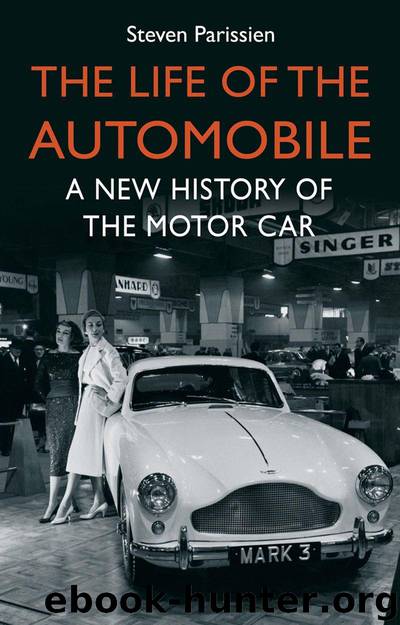Life of Automobile, The by Steven Parissien

Author:Steven Parissien
Language: eng
Format: mobi, epub
Publisher: Atlantic Books
Published: 0101-01-01T00:00:00+00:00
Nineteen fifty-nine in Britain was a motoring annus mirabilis, too: the year of the Mini, the Ford Anglia, the Triumph Herald and the impeccably styled Jaguar Mark 2 – four of the most innovative (and handsome) cars in the world. The Mini in particular broke new ground and has deservedly come to be regarded as one of the world's classic cars, one which changed the face of motoring and transformed how cars were configured.
BMC boss Leonard Lord was determined to develop a ‘proper’ car to trounce the Germans; in 1957 he demanded that BMC's designer Alec Issigonis ‘drop everything . . . and build me something to beat the bloody bubble cars’, and he championed Issigonis's Mini from the start. Yet the Mini was not the first innovative small car that BMC produced. In 1958 the combine had launched the new-look Austin A40, a revolutionary ‘two-box’ design which was a sharp contrast to the ‘three-box’ pattern of bonnet/hood, glasshouse, and boot/trunk to which most cars then conformed. The A40’s snappy, angular design, commissioned from Giovanni Battista Farina's Turin-based Carrozzeria Pininfarina coachbuilding operation, was light years away from the comforting, rounded shapes that BMC loved. And with its rear access door, BMC had, in the A40, effectively created the world's first hatchback.
‘Pinin’ Farina was born in Turin in 1893 and began work for Fiat aged only seventeen. His infant nickname ‘Pinin’ – ‘baby’ in the Piedmontese dialect – stuck with him all his life; indeed, in 1961 he legally changed his name to Battista Pininfarina. Depressed by the lack of work in Mussolini's Italy, Farina, along with thousands of Italians, emigrated to America. However, he found the US little better; declining the offer of a menial job at Ford, he soon returned to Italy to work in his brother's body shop. Farina founded his own company in 1930, but it was only after the Second World War that his business really took off, when he was asked to design car bodies for Fiat, Lancia, Alfa Romeo and, after 1952, Ferrari. In 1957 BMC decided to try and enliven their products by introducing some Italian visual flair and, controversially, invited Farina to help design not only the A40 but also the new Morris Oxford and its BMC stablemates, the Austin Cambridge, the MG Magnette and the Riley 4/68. Peugeot had the same idea, and ended up with the Pinfarinastyled Peugeot 404 of 1960 – a car that looked strikingly similar to Farina's Morris Oxford.
So pleased was BMC with Pininfarina's work on the A40 that they originally added a suffix, Farina, to the car's official name. Sadly, the car's underpinnings did not live up to the promise of Pininfarina's crisply styled body. Underneath, indeed, the car was virtually identical to the oldfashioned if loveable Noddy car, the A30/A35, which had been introduced by Austin in 1951 as their answer to the Morris Minor. The A40 even shared the A35’s 948cc engine and running gear; only in 1962 were these features updated. For its breakthrough model, BMC needed a wholly new concept.
Download
This site does not store any files on its server. We only index and link to content provided by other sites. Please contact the content providers to delete copyright contents if any and email us, we'll remove relevant links or contents immediately.
| Buyers' Guides | Classic Cars |
| Customize | Driver's Education |
| Electric & Hybrid | Foreign |
| History | Industry |
| Insurance | Luxury |
| Motorcycles | Pictorial |
| Racing | Repair & Maintenance |
| Trucks & Vans |
Machine Learning at Scale with H2O by Gregory Keys | David Whiting(4179)
Never by Ken Follett(3790)
Urban Outlaw by Magnus Walker(3340)
OPNsense Beginner to Professional by Julio Cesar Bueno de Camargo(3251)
Sapiens and Homo Deus by Yuval Noah Harari(2987)
Will by Will Smith(2792)
A Short History of Nearly Everything by Bryson Bill(2629)
Hooked: A Dark, Contemporary Romance (Never After Series) by Emily McIntire(2500)
Rationality by Steven Pinker(2291)
Borders by unknow(2227)
The Becoming by Nora Roberts(2087)
Holy Bible (NIV) by Zondervan(2086)
The One Percenter Encyclopedia by Bill Hayes(1787)
HBR's 10 Must Reads 2022 by Harvard Business Review(1776)
Freedom by Sonny Barger(1771)
A Short History of War by Jeremy Black(1762)
Five Ways to Fall by K.A. Tucker(1700)
Go Tell the Bees That I Am Gone by Diana Gabaldon(1687)
Girls Auto Clinic Glove Box Guide by Patrice Banks(1684)
